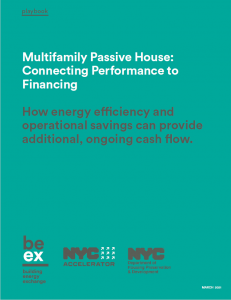 The Building Energy Exchange—in collaboration with Bright Power, New York City Department of Housing Preservation and Development (NYC HPD), The Community Preservation Corporation (CPC), and Steven Winter Associates (SWA)—released a report and playbook that analyzes energy use, emissions, and operational cost data from six New York City multifamily Passive House buildings. Different from other resources, this playbook compares that data to data from peer buildings built to code.
The Building Energy Exchange—in collaboration with Bright Power, New York City Department of Housing Preservation and Development (NYC HPD), The Community Preservation Corporation (CPC), and Steven Winter Associates (SWA)—released a report and playbook that analyzes energy use, emissions, and operational cost data from six New York City multifamily Passive House buildings. Different from other resources, this playbook compares that data to data from peer buildings built to code.
For sustainability professionals and forward-thinking building owners and operators, this isn’t news. But what’s groundbreaking about this report is that this data can increase building owners’ access to private debt and, in the case of some affordable housing, may also decrease reliance on public subsidies.
Future research will focus on developing better tools for lenders and collecting data from a larger set of buildings. A capstone team from the City College of New York (CUNY) Sustainability in the Urban Environment program is currently working on a multifamily Passive House database, which uses an online survey to collect data from projects in New York and similar North American climates. You can learn more and contribute to the database on CUNY’s website.